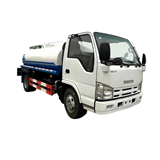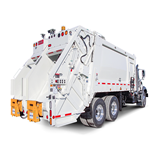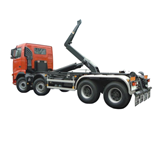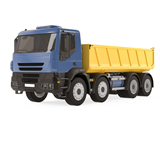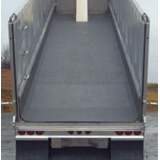Looking to buy a water truck in Australia? Get pricing, key specs, maintenance tips, and compliance insights for civil and construction projects.
Key takeaways
- Water truck prices in Australia range from $80,000 to over $250,000 depending on capacity, chassis brand, configuration, and custom features.
- Tank capacities typically range from 5,000L to 20,000L, with 8,000L–12,000L models most common for construction and civil work.
- Operational costs (fuel, maintenance, parts) average $12,000–$20,000 per year, depending on usage intensity.
- Hiring rates for water trucks in Australia start at $90–$150/hour, making purchasing more cost-effective for long-term or frequent use.
- Key industries using water trucks include construction, mining, dust suppression, agriculture, and roadworks.
- Finance options include chattel mortgages, leases and hire purchase agreements, often starting at 6.5% annual interest (as of 2025).
- National Heavy Vehicle Regulator (NHVR) registration and compliance with Australian Design Rules (ADRs) are mandatory.
- Buyers should inspect spray systems, tank construction, PTO pumps, and baffles for durability and operational efficiency.
Introduction
Whether you're in civil construction, mining, road maintenance, or agriculture, a water truck is a backbone asset when it comes to dust suppression, compaction, or even firefighting. For Australian businesses, the decision to buy a water truck requires careful consideration of capacity needs, compliance obligations, operational costs, and long-term ROI.
This buying guide explores everything you need to know, from pricing and types to financing and maintenance, so you can confidently invest in the right machine for your operation.
Types of water trucks available in Australia
Water trucks vary greatly in terms of design, tank capacity, spray systems, and vehicle chassis. Below are the most common types found in the Australian market:
1. Rigid body water trucks
- Description: Built on a rigid chassis (e.g., Isuzu, Hino, Mitsubishi).
- Tank capacity: Typically 5,000L–15,000L.
- Best for: Urban construction sites, dust suppression on sealed/unsealed roads.
2. Articulated water carts
- Description: Heavy-duty, high-capacity trucks with articulated joints.
- Tank capacity: 20,000L and above.
- Best for: Mining, large-scale earthworks.
3. Hook-lift and skid-mounted tanks
- Description: Portable tanks that can be loaded onto trucks or trailers.
- Best for: Multi-purpose fleets or contractors needing flexibility.
4. Off-road water trucks
- Description: Custom-built for rough terrain.
- Common in: Remote mining sites or agricultural fire suppression.
Price guide: How much does a water truck cost in Australia?
New water truck prices in 2025
If you're buying a brand-new water truck in Australia, here's what you can expect in terms of cost based on tank capacity and configuration:
- 5,000L to 7,000L models generally fall between $80,000 and $110,000, depending on the chassis brand, tank construction (steel vs poly), and basic spray equipment.
- 8,000L to 12,000L trucks, which are the most commonly used on civil and construction sites, typically range from $115,000 to $180,000. Prices at the higher end usually include automated spray control systems and stainless tanks.
- 15,000L and above capacities will usually cost $190,000 to over $250,000, especially if they're fitted for higher GVM ratings or with premium spray systems for mining or infrastructure work.
- Custom-built articulated water trucks, commonly used in large-scale mining and major infrastructure projects, can range from $250,000 to $350,000 or more, depending on the scale, spec, and supplier lead times.
Keep in mind that prices fluctuate based on supply chain conditions, local fabrication availability, and the type of pump and control systems installed. Always ask for an itemised quote.
Used water trucks
- 5–10 years old trucks can cost $50,000–$100,000, depending on usage hours and service history.
- Ensure tanks are certified and not rusting internally.
How water trucks operate: Key components and workflow
Water trucks function through a coordinated system of mechanical, hydraulic, and electronic components, all designed to safely transport and precisely distribute water for various industrial and civil applications.
Key components and how they work
- Pump system: The heart of any water truck, the pump draws water from the tank and pushes it through spray nozzles. Most Australian models use a PTO (Power Take-Off) system connected to the engine, though hydraulic and electric pump alternatives are gaining traction for energy efficiency. For high-capacity units, flow rates of 1,000–3,000 litres per minute are typical.
- Spray bars and nozzles: Strategically mounted under the rear or sides of the tank, these bars use multiple adjustable nozzles to deliver water in a controlled fan or jet pattern. Some models also include side sprayers or water cannons for wide coverage or emergency use.
- Cab controls: Operators can engage the spray systems directly from the truck’s cabin, adjusting pressure, spray direction, and timing. Modern units offer touchscreen programmable systems with GPS-based automation for consistent application across work zones.
- Internal baffles: These are steel or poly walls built inside the tank to minimise water movement (sloshing) during transit. Without baffles, trucks are harder to brake and corner safely. Baffles are mandatory under most NHVR guidelines for tanks exceeding 5,000 litres.
Common applications
- Dust suppression: Essential for construction sites, unsealed roads, and mining operations. Most contracts require minimum spray widths and water volume delivery per square metre.
- Soil compaction: Roadworks and civil sites rely on water trucks to provide consistent moisture levels for compaction during grading or asphalting.
- Fire prevention: In rural and remote areas, water trucks support firefighting efforts during bushfire season or are stationed on agricultural land as mobile fire response units.
- Turf and landscape irrigation: Councils and private contractors use smaller-capacity trucks to water grass and plantings where fixed irrigation isn’t viable.
Maintenance and parts: What you’ll need to budget for
Owning a water truck means committing to regular maintenance and parts replacement to avoid costly downtime. Proactive servicing ensures compliance, safety, and a longer operational lifespan, especially in rugged Australian environments.
Key maintenance tasks
- Pump servicing (every 250–500 hours): Includes checking seals, bearings, and impellers. A failed pump can halt operations entirely, so proactive maintenance is crucial.
- Spray nozzle cleaning: Nozzles should be inspected weekly for clogs, especially when using recycled water. Blocked nozzles can cause uneven spray patterns or increased pressure in the lines.
- Tank integrity inspections: Regularly check for signs of corrosion, cracks, or weld failures, particularly in steel tanks operating in saline or dusty environments. Look inside the tank with a light every 3–6 months.
- Chassis and driveline servicing: Follow the original truck manufacturer’s intervals (often every 10,000–20,000 km). Include suspension and brake system checks, especially for off-road use.
Common parts to monitor or replace
- Spray nozzles: $30–$120 each depending on type and flow rating.
- PTO or hydraulic pumps: $1,200–$2,500 depending on make and capacity.
- Tank baffles: $500–$1,500 per set. Missing or broken baffles can void road registration.
- Hoses, clamps, and valves: $50–$300 depending on size and pressure rating.
- Control systems and solenoids: $300–$1,000 for basic replacements.
Pro tip: Stainless steel tanks or epoxy-coated steel options are highly recommended in coastal or mining environments to minimise corrosion and reduce long-term maintenance costs.
Financing a water truck in Australia
A new water truck is a significant investment, often upwards of $150,000. For many Australian operators, especially smaller businesses or regional councils, financing provides flexibility and helps preserve working capital.
Common finance options
1. Chattel mortgage
- Best suited for ABN holders who want ownership from day one.
- Full GST claimable on purchase (if GST-registered).
- Fixed or variable rate terms, starting from 6.5% p.a. in 2025.
- Can include insurance and servicing in the loan package.
2. Commercial hire purchase
- Ideal for buyers needing asset use without upfront capital.
- Full control over the asset, with the option to own it at the end of the term.
- Repayments are tax-deductible.
3. Operating lease
- Suitable for projects or councils needing short- to medium-term access.
- Keeps the asset off your balance sheet.
- Maintenance and registration often included in lease packages.
Sample repayment structure (2025 estimate)
For a $150,000 loan over 5 years at 6.5% interest:
- Monthly repayment: Approx. $2,930/month
- With 30% balloon (residual): Lower repayments, approx. $2,200/month with a final payout of $45,000
Warranties and after-sales support
When purchasing a water truck, understanding the warranty structure and ongoing support is just as important as the spec sheet.
What’s typically covered?
- Chassis warranty: Provided by the truck OEM, covering drivetrain and electronics, usually 3 to 5 years or up to 200,000 km.
- Tank and spray equipment warranty: Offered by the tank manufacturer or upfitter. Generally 1 to 2 years, covering weld integrity, pump failure, and basic components.
- Extended warranties: May be available for heavy-use environments like mining or large-scale construction. Often includes pump systems and control electronics.
After-sales considerations
- Onsite servicing: Some suppliers offer mobile service teams for rural and regional clients, especially during project ramp-up periods.
- Parts availability: Choose local tank builders or distributors with Australian parts warehouses. Delays in overseas shipments can cost you days of project downtime.
- Emergency callouts: Critical for infrastructure contractors working to schedule. Check if 24/7 support is included.
Compliance and certification in Australia
Purchasing and operating a water truck involves meeting a range of national and state regulations. Failure to comply can result in fines, downtime, or cancelled contracts.
1. Vehicle certification
- Must comply with Australian Design Rules (ADRs) for heavy vehicles, including lighting, brakes, emissions, and structure.
- Needs to be registered with the National Heavy Vehicle Regulator (NHVR).
- PBS (Performance-Based Standards) approval is required if the truck has custom features that affect stability or loading (e.g. oversized tanks).
2. Tank and pressure equipment standards
- All pressurised components must meet AS 1210 (Pressure Vessels) and AS 1657 (Access and walkways).
- Backflow prevention devices are required if filling potable water or operating on shared council supply lines.
- Safety railings, ladders, and platforms must meet fall protection standards.
3. Spray system and roadworthiness
- Water discharge must comply with state EPA regulations, especially in dust suppression applications. Over-spraying or run-off into stormwater systems can attract penalties.
- Trucks must pass annual roadworthiness inspections, including brake testing and lighting compliance.
4. Operator licensing and training
- Drivers must hold at least a Medium Rigid (MR) or Heavy Rigid (HR) licence, depending on the vehicle's GVM.
- For mining or infrastructure projects, operators may need:
- White Card (Construction Induction)
- Mine site inductions or Tier 1 builder accreditations
- Water cart operations tickets in some cases
Questions buyers often ask (FAQs)
Q: Is it better to buy new or used?
For long-term use and critical infrastructure work, buying new provides better ROI through improved reliability and warranty support. Used trucks are viable for short-term projects or seasonal usage, just be sure to inspect spray systems, rust, and odometer readings.
Q: Can I retrofit a water tank onto an existing truck?
Yes, many businesses do this. Ensure:
- Chassis has the correct GVM rating
- You use a certified tank builder
- You obtain a new mod plate and engineering certification
Q: How much water can I legally carry?
This depends on your Gross Vehicle Mass (GVM) and local road regulations. A 10,000L tank requires a truck with at least 15–18 tonne GVM to remain compliant and safe.
Q: Are there electric or hybrid water trucks in Australia?
As of mid-2025, electric water trucks are still rare due to weight limitations and power requirements. Some councils are trialling hybrid PTO pumps, but widespread adoption is 2–3 years off.
Q: What’s the lead time for delivery?
For custom-built water trucks, expect:
- 8–12 weeks if chassis is in stock
- 12–20 weeks for full builds or imported units
- Faster turnaround if buying from a stock dealer
Final thoughts: What to do next
Buying a water truck is a significant investment, but with the right preparation, it can also be a highly profitable one. Define your intended application, compare models by tank type and pump power, and factor in compliance and operating costs early in your decision-making.


